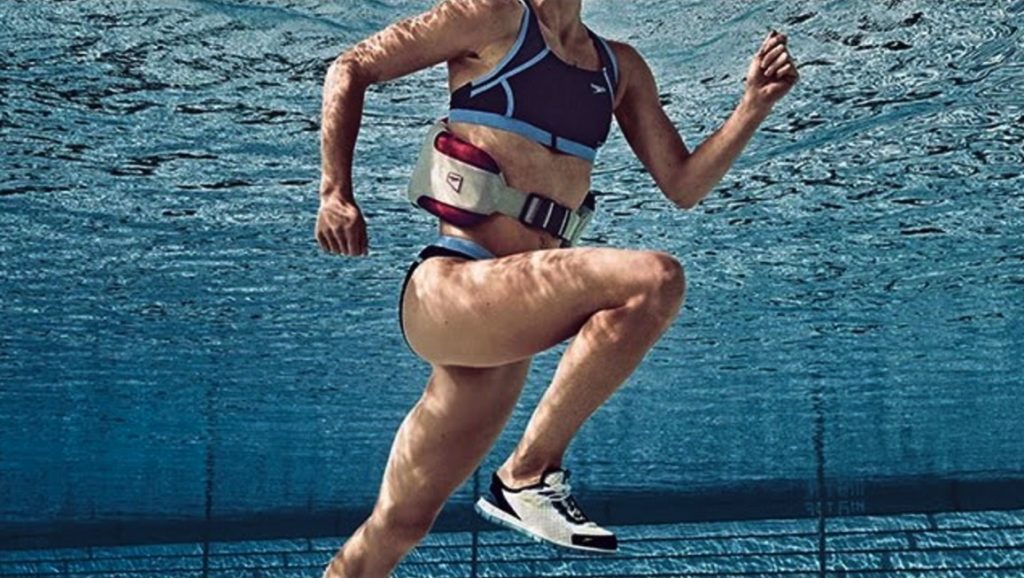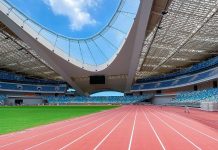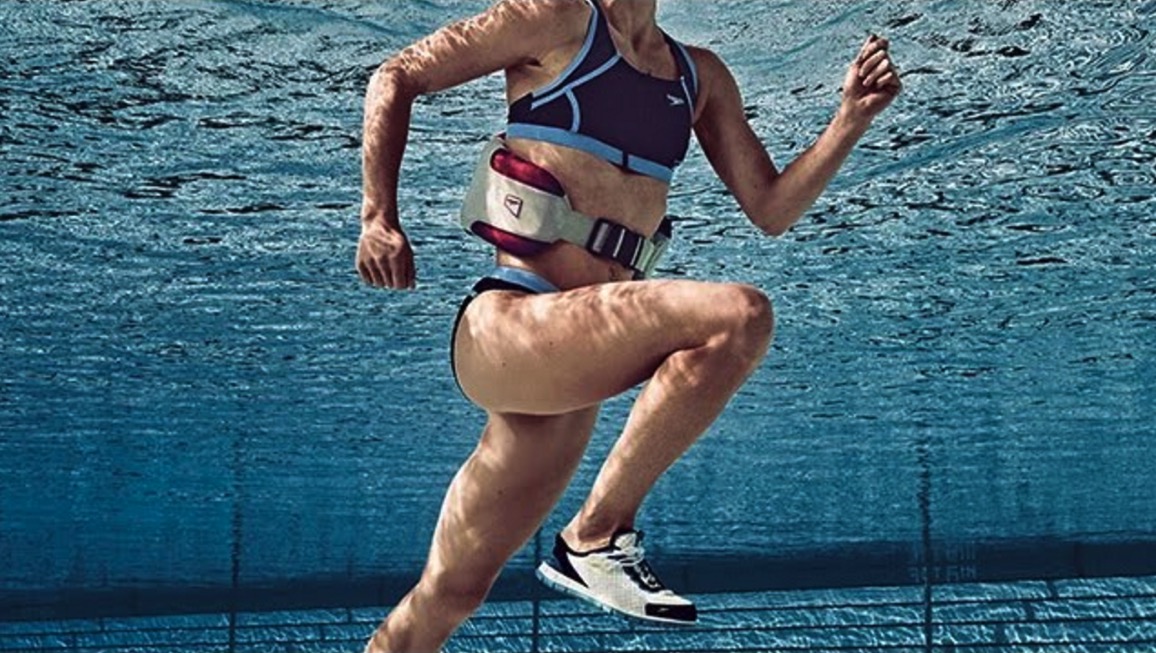Deep water running provides an excellent cross training strategy for building and maintaining fitness during periods of injury and as part of an injury rehabilitation program.
Deep water running is also an extremely effective training tool during the competition season and high intensity training periods of the year.


DEEP WATER RUNNING.
BY LESLEY GRIMES.
Why Deep Water Running can benefit Athletes.
ABSTRACT:
The purpose of this article is to assist coaches in optimising their athletes training programs with the inclusion of deep water running.
The focus of the article is on sports specific exercise combined with an effective deep water running program.
Deep water running provides an excellent cross training strategy for building and maintaining fitness during periods of injury and as part of an injury rehabilitation program.
Deep water running is also an extremely effective training tool during the competition season and high intensity training periods of the year.
ARTICLE:
Deep water running consists of simulating dry land running in the deep end of the pool with the use of a floatation belt. The running form of the participant must follow the running pattern used on land as close as possible.
For this reason it is advised athletes have familiarisation sessions in the water before they commence any specific training in deep water so the athlete can reproduce correct technique and running form.
THE BENEFITS OF DEEP WATER RUNNING:
· The non weight bearing nature reduces the shock and trauma to the lower limbs.
· The increased resistance of water enhances strength and flexibility for both upper and lower extremities.
· Excellent for recovery, rehabilitation and prevention of injury.
· Workloads can be increased without the associated muscle soreness.
· Sports specific drills can be reproduced in deep water.
· Sports specific strength and flexibility exercises can be incorporated into deep water exercise program.
HEART RATES (HR) AND RATE OF PERCEIVED EXERTION (RPE)
Athletes will often estimate their exercise intensity by using Rate of Perceived Exertion rather than Heart Rate. Borg 1982 developed a scale that correlates RPE and HR This demonstrated a strong linear relationship between RPE and HR with increased exercise intensities.
Hammer and Slocombe (1997) examined the relationship between HR and RPE for Deep Water Running and Treadmill Running. 12 subjects were used. They performed 6 sub-maximal incremented work intensities running on the treadmill and in deep water. Each time exercise intensity was increased the subjects provided RPE between 6 (very light) and 20 (very hard) to reflect total body fatigue. This scale was developed to correspond with approximate to HR’s ranging from 60 to 200 beats per minute. The results indicated that running on the treadmill and in deep water with the same RPE produced a HR that was on average 17 beats per minute lower in the water than on the treadmill. It was suggested this was because of and increased cardiac output via and increased stroke volume produced by shunting of blood from the periphery, occurring due to the hydrostic pressure of the water which increased the venal return and inturn stroke volume. This indicates that conventional methods of using HR and RPE in exercise prescription for land running may need to be modified for deep water running. In the study several reasons were provided for this.
· Reduced peak HR (22 beats/min lower).
· Reduced Vo2 max (17% lower) in max deep water running compared with treadmill running.
Comparing a similar RPE of deep water running and treadmill running produced lower:
· Heart rates.
· O2 uptake.
· Respiratory quotient.
· Ventilation.
This indicates that if using target HR’s in deep water running, they should be set on average 17 bpm lower than land running taking into account the effect of water. If using land RPE scores to set intensity levels for deep water running expect lower HR in the water compared to land running. n. Heart rates are reduced during deep water running sessions in comparison to land running.
CORRECT TECHNIQUE:
· Slight forward lean.
· Correct arm action. Elbows come right back through the water.
SAMPLE WARM UP FOR A COMPETITIVE RUNNER:
· 200 – 500 meters of relaxed swimming using front and back strokes.
· 5 to 10 mins of ¾ pace running. Non swimmers may run only.
SAMPLE PROGRAM OF DYNAMIC FLEXIBILITY DRILLS:
3 sets of drills over distance of 10 to 15 meters.
Recovery 1 minute between sets.
· Marching.
· Slalom ski.
· High fast knees.
· Star jumps.
SAMPLE STRENGTH PROGRAM FOR LOWER LIMBS:
· 5 mins of vertical kicking.
· 10 laps of hard kicking with a kick board. Recovery 30 sec to 1 minute between each rep.
SAMPLE STRENGTH PROGRAM FOR UPPER LIMBS:
· White water arms.
Drive arms vigoursly out of the water while maintaining a stable body position.
5 x 10 secs hard/10 seconds recovery.
· Push ups.
· 10 to 20 repetitions.
Hands on pool deck. Lift body out of the pool until arms are straight.
SAMPLE PROGRAM FOR ALL OVER STRENGTH:
· Vertical kick with kick board held above the head.
Hold the kick board above the head, arms fully extended, while vertical kicking. Once the board can no longer be held or form is lost, recover for 1 minute then repeat one to two times.
· Life jacket and rope.
Attach a rope to a life jacket and the end of the pool. Run intervals away from the rope while maintaining sprint action.
SAMPLE INTERVAL SESSION:
· 2 x 2 mins/1 min recovery.
· 4 x 90 seconds/1 min recovery.
· 4 x 60 seconds/30 seconds recovery.
Note: Explosive jumps can be included in chest depth water providing there are no injuries to the joints.
SAMPLE CONDITIONING SESSIONS FOR A COMPETITIVE RUNNER:
Aerobic:
· 8 x 2 mins/30 sec to 1 minute recovery.
Heart rate 170 bpms. Recovery heart rate 120 bpms.
Speed Endurance:
· 6 x 30 sec/20 sec recovery.
· 6 x 40 sec/20 sec recovery.
· 3 x 1 min/30 sec recovery.
Speed:
· 3 sets of 6 x 10 sec sprint max effort/50 sec recovery treading water.
2 min recovery between sets.
Warm down should include some relaxed running, lap swimming and stretching.
CONCLUSION:
There are many other combinations for training sessions in deep water. The coach can create programs to match the movement patterns of their sport and the conditioning and flexibility requirements of their sport.
Deep water running should be considered as a vital element of an athletes training program.
ABOUT THE AUTHOR:
Lesley Grimes is a National Accredited:
· ATFCA Level 4 Middle/Long Distance Running Coach.
· Level 2 ASCA Strength and Conditioning Coach.
· Aqua Exercise Instructor.
· Personal Trainer.
REFERENCES:
Brow C. Murrie D. Getting into Deep Water, Peak Performance Issue 223.
Borg 1982 psychophysical basis of perceived exertion Medicine and Sport Science in Sport and Exercise 14.377.
Nancey K Botho PHD, Mary Tucker MS, Christine Greening MS. Physiologic responses to maximal treadmill and deep water running in men and women. American Journal of Sports Medicine.Am.J.Sports Meds, Dec 1991; 19612.614
Kilding AE, Scott MA, Mullineaux Dr. A kinematic comparison of deep water running and over ground running in endurance runners. J Strength Cond Research May 2007. 21(2): 476-80 PMID: 17530939.
De Maere Jm Ruby BC. Effects of deep water running and treadmill running on oxygen uptake and energy expenditure in seasonally trained cross country runners. J Sports Med Phy Fitness September 1997; 37(3):175-81 PMID: 9407747.
Rod Cedaro. In the deep end water running. AIS Applied research centre publication 2005.
Robin Horne. The physiology of deep water running as a training program. Curtin University of Technology – Physiotherapy.
Kaneda K, Wakabayashi H, Sato D, Nomura T. Lower muscle activity during different types and speed of underwater movement. J Physiol Anthropol March 2007. 26(2):197-200 PMID: 17435365.
Kaneda K, Wakabayashi, Sato D, Vickusa T, Nomura T. Lower muscle activity during deep water running on a self determined pace. J Electromyogram Kinesiology June 13th 2007.PMID 17572106.
Killgore GL, Wilcox AR, Caster BL, Wood TM. A lower – extremities kinematic comparison of deep water running styles and treadmill running. J Strength Cond Res Nov 2006, 20(4): 919-27 PMID: 17149985.
Reilly T, Ekblom B. The use of recovery methods post-exercise. J Sports Sci June 2005; 23(6):
Burns AS, Lawder TD. Deep Water Running: An effective non-weight bearing exercise for maintenance of land based running performance. Mil Med Mar 2001, 166(3)253-8PMID:11263030.
Reilly T, Dowzer CN, Cable NT. The physiology of Deep Water running. J Sports Science Dec 2003 21(12):959-72PMID:14748454.
Speed Development through resisted sprinting. B Newman, MS, CSCS. NSCA’s Performance Training Journal. Vol 6 No3/page 13.
Article thanks to LESLEY GRIMES – Published on Runner’s Tribe with permission from the author.
Visit http://www.glenhuntly-athletics.com/ for more great articles and information.






























Comments are closed.